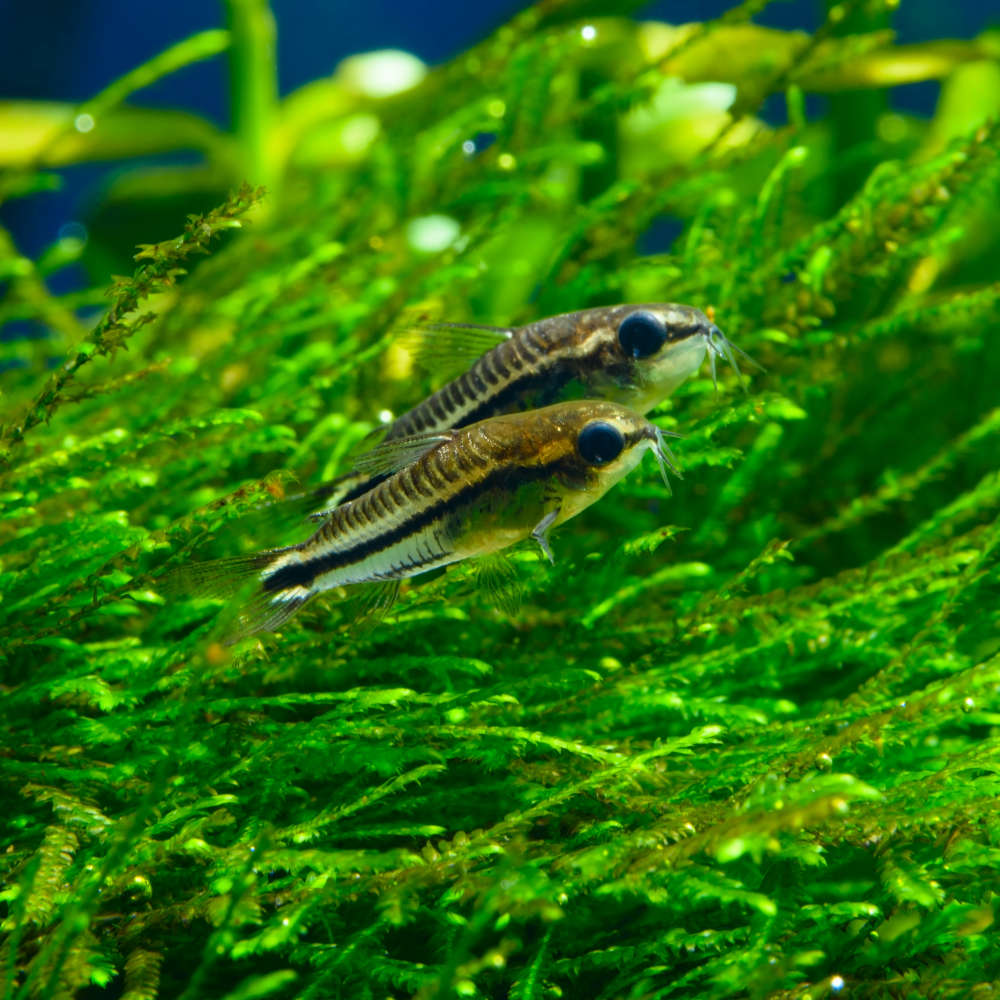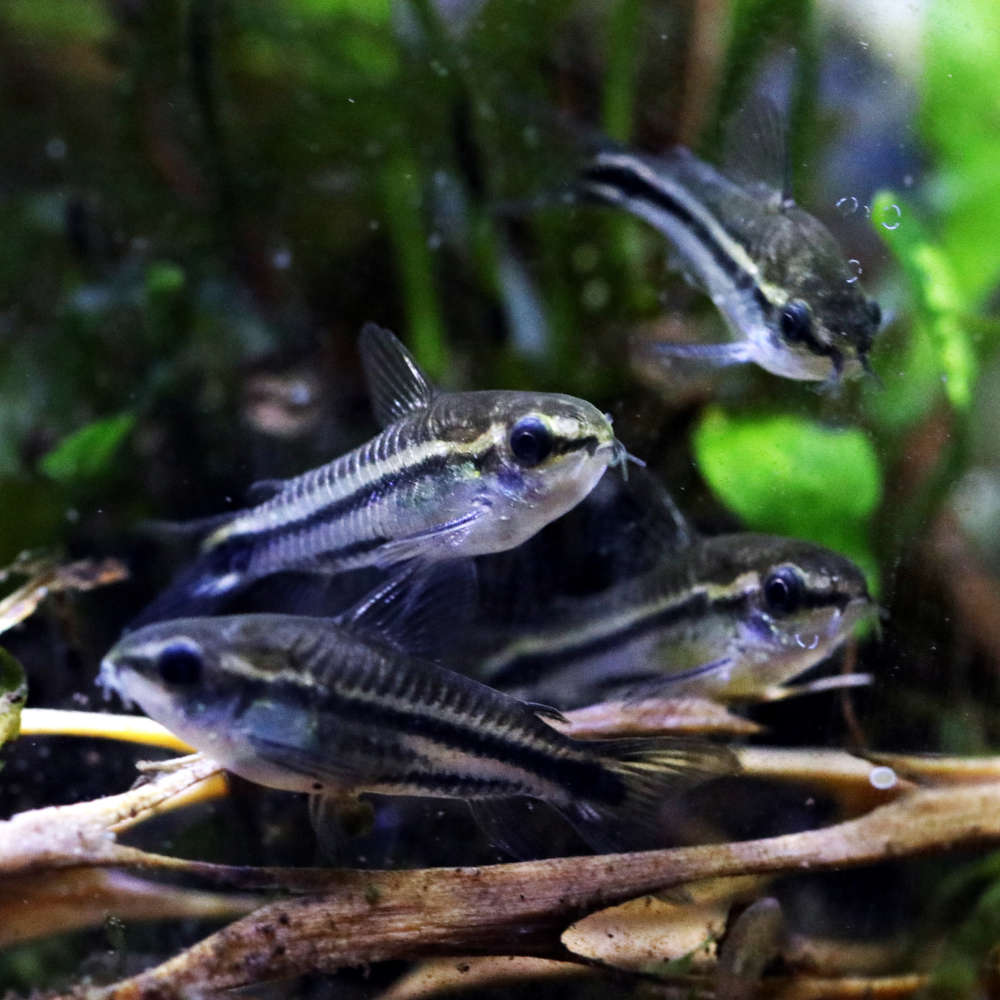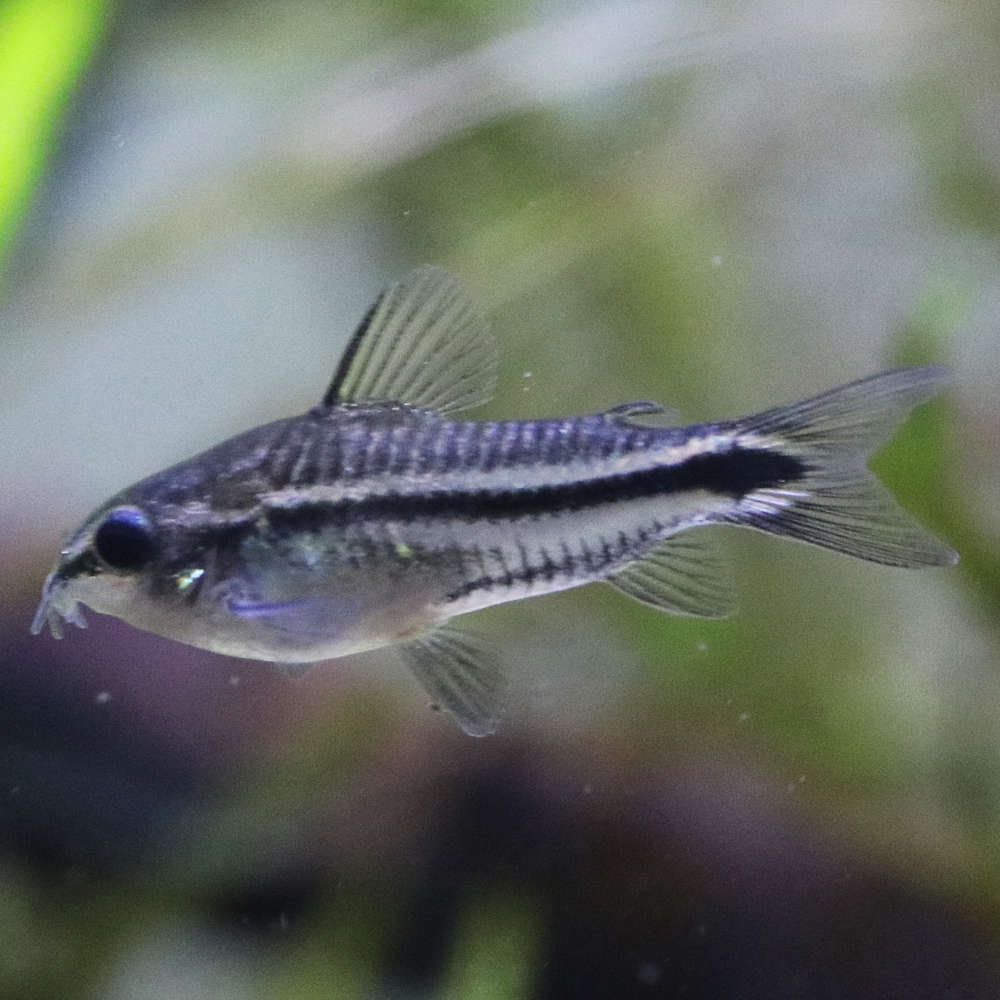If you want an easy-to-care-for and cute-looking freshwater fish, try out a bunch of pygmy corydoras. These fish are loved by both pro and novice aquarists.
Owing to their playful nature, you’ll never be bored of watching them. When they swim with their shoal, they seem like a glistening sheet of stars in your tank.
So, if you’re interested in getting them home, let’s get started!
What is Pygmy Corydoras?
A Pygmy Corydoras is a freshwater fish belonging to the Callichthyidae family and is quite popular, for its big eyes, among all types of fish keepers and aquarists.
| Origin | Madeira River basin, South America |
| Order | Siluriformes |
| Family | Callichthyidae |
| Scientific Name | Corydoras pygmaeus |
| Common Names | Pygmy corydoras, pygmy catfish |
| IUCN Red List Status | Not Evaluated |
| Appearance | Silver teardrop-shaped fish with a thick black horizontal line across the center of sides |
| Size (Adult) | Around 3 cm (1.2 in) |
| Lifespan | Usually up to 3 years; 5 years with best care |
| Temperament | Peaceful, shoaling |
| Tank Level | Middle and bottom dwellers |
| Water Temperature | 72-79 °F (22-26 °C) |
| pH Level | 6-8 |
| Water Hardness | Up to 8 dGH |
| Care Level | Easy |
| Minimum Tank Size | 20 gallons for 10-15 |
| Tank Environment | Sandy, planted tank with hiding spots |
| Diet | Omnivorous |
| Tank Mates | Similar-sized, similar-tempered species |
Where is Pygmy Corydoras found naturally?
In the wild, the pygmy corydoras is spotted in the Madeira River basin (western Brazil), the Nanay River tributaries (Peru), and the Aguarico River tributaries (Ecuador), South America.
It stays in large groups in the vegetated zones of creeks, flooded forest areas, and pools.
Which family does Pygmy Corydoras belong to?
This catfish belongs to the Callchthyidae family under the Siluriformes order. It is scientifically known as Corydoras pygmaeus, but is popular worldwide as pygmy corydoras and pygmy catfish.
Fun Fact: Pygmy corydoras is ideal for aquascaping as it’s one of the smallest fish.
How does Pygmy Corydoras look?

Now, if you’re curious about how this fish looks, let’s get started…
What is the Size of Pygmy Corydoras?
On average, the pygmy corydoras is pretty small and reaches a maximum of up to 3 cm (1.2 in).
What is the Color of Pygmy Corydoras?
The silver-colored pygmy catfish has a thick black line running horizontally along the center of its sides – from its snout to its tail fin. Another thinner black line runs along its abdomen that extends from behind its ventral fin until the tail.
Its top is dark grey, which begins at the top of its snout and extends to the tail.
What are the main features of Pygmy Corydoras?
Like most other corydoras, it has a teardrop-shaped build, a large head, and an underturned mouth. There are barbels around the mouth.
How is a male and a female Pygmy Corydoras different?
When looked at from the top, the female pygmy catfish looks broader than the male counterparts – especially when she carries eggs. In terms of size, the adult female is about 2.5 cm (1 in), and the mature male is around 1.9 cm (0.75 in).
What is the Behavior & Temperament of Pygmy Corydoras in an aquarium?
The pygmy corydoras is peaceful, shy, and friendly. It feels comfortable and confident in shoals of 10 or more.
It’s also more active and adventurous at night, during water changes, and during mealtimes. The catfish loves to explore the middle water levels. When hungry, it swims to the bottom and searches for food with the barbels.
What is the Lifespan of Pygmy Corydoras?
On average, pygmy corydoras lives for 2-3 years. But with the best care, you can sustain it for up to 5 years.
Author’s Note: Between the 1920s and 1950s, pygmy corydoras were mistakenly identified as dwarf corydoras (Corydoras hastatus).
How to take care of Pygmy Corydoras?

If you’re eager to get this fish for your aquarium, let’s know everything to make it feel at home!
What is the recommended Tank Size for Pygmy Corydoras?
Invest in a 20-gallon tank for a shoal of about 10-15 of them. If you want to add more, upgrade by two gallons per fish. Upgrade the size accordingly to build a community tank.
Many suggest keeping a group of 6-8 in a 10-15 gallon tank. But in my experience, this group is too small. They’ll be too afraid to explore and might even shorten their lifespan. A group of 10 or more is the most sustainable.
Other than that, smaller or nano aquariums also need higher water flow rates to ensure proper filtration and aeration. But the pygmy needs a medium to slow current.
What is the Water Chemistry for Pygmy Corydoras?
To ensure that your pygmy buddies stay healthy, you must follow these water parameters.
- pH Levels: 6-8
- Water Temperature: 72-79 °F (22-26 °C)
- Water Hardness: Up to 8 dGH
- Ammonia: 0 ppm
- Nitrite: 0 ppm
- Nitrate: Below 20 ppm
What should be the Tank Environment for Pygmy Corydoras?
To make your fish exhibit behavior similar to the wild, take special care of its environment. So, let’s learn to set things up here…
1. Substrate
The catfish often swims to the bottom level of the tank and digs the substrate in an attempt to find food. It also has sensitive barbels for food-seeking.
Sharp substrates like rocks and gravel may damage the barbels and leave the fish harmed. So, choose a fine-grained substrate like soft and fine sand. It’s also perfect for digging and burrowing.
2. Plants
In the wild, pygmy cory sticks close to plants and fallen trees. So, go all out with tall background plants and short foreground plants. Ensure all plants have soft leaves and stems to keep your pet fish safe.
Some options are grass and moss. Use plants with large, broad leaves in the base as a hammock for your fish.
3. Lighting
The shy species are comfortable with dim lighting. So, use dim lights or adjustable LEDs. Additionally, use floating plants like duckweed to diffuse the light.
4. Décor
To mimic the fish’s natural habitat, use smooth aquarium rocks or driftwood as decor. Dried oak, beech, twisted roots, and bogwood are also great options.
Similar to its native environment, stain the tank water with tannins. Use Indian almond leaves to replicate that. Remove old leaves before they rot to maintain a safe environment.
Add shrimp flats as hiding spots.
5. Filtration
It’s best to install a sponge, power, or box-type filter for these dwarf species. These ensure the water current isn’t too fast and the inlet tube is too small for the fish to enter.
If you have a planted tank, the canister is your best bet.
Additionally, perform a 10-25% water change twice or once a month.
6. Water Flow Rate
The corydoras prefers medium to slow water currents. Faster currents may stress your pet.
Fish Care Tip: There’s a misconception that pygmy cories are great algae eaters. But algae doesn’t have enough nutrition to sustain your pygmies. So, don’t let them starve in an algae-covered tank.
What does Pygmy Corydoras eat?
Pygmy cory is omnivorous, so it accepts a variety of food. But it clearly loves live or frozen food which helps it retain the bright body sheen. Some choices are:
- Tubifex worm
- Microworm
- Nematode
- Bloodworm
- Black worm
- Insect larvae
- Brine shrimp
- Grindal worm
- Water flea
- Pellet
It can consume dried food, but those are not nutritious. So, supplement dried food with any of the above-listed foods.
You can also feed it chopped green vegetables and algae wafers. Make sure all food is chopped or ground into small pieces before feeding them. Otherwise, the fish’s small mouth won’t be able to eat them.
Feed your pet once a day for 5 minutes.
What are the Tank Mates for Pygmy Corydoras?
Before you add other tank mates, ensure there are at least 10-15 pygmy cories in your tank. This will promote playfulness among them.
Next, to build a community tank, choose from the following similar-sized peaceful species:
- Ember tetra
- Neon tetra
- Zebra danio
- Celestial pearl danio
- Dwarf gourami
- Kuhli loach
- Otocinclus catfish
- Chilli rasbora
- Panda garra
- Albino bristlenose pleco
- Apistogramma
- Molly fish
- Guppy fish
- Endlers livebearers
- Pencilfish
- Hatchetfish
- Cherry barb
- Dwarf ember barb
- Chinese algae eater
- Freshwater snails
Which Tank Mates to Avoid for Pygmy Corydoras?
Never house pygmies with
- Aggressive and bigger tank mates: They will intimidate, harm, or eat the pygmies.
- Fast-swimmers: They steal the slow-swimming pygmies’ food.
- Too small species: They’ll get eaten by your pygmies.
Some species you must be careful about are:
- Betta fish
- Larger catfish
- Siamese algae eater
- Angelfish
- Cichlid
- Paradise fish
- Goldfish
- Jack Dempsey
- Oscar fish
- Baby shrimp
- Crayfish and crabs
What are the Common Diseases for Pygmy Corydoras?
The pygmy cory is susceptible to fin rot, ich, and white spot diseases. But other than that, here are a few more diseases that you must be careful about:
| Disease Name | Causes | Symptoms | Treatment |
|---|---|---|---|
| Red Blotch Disease | Stress from unstable water parameters | Bloody red sore on the entire body | Medication (Seachem KanaPlex, API furan 2) |
| Skin & Gill Flukes | Parasitic Infection – from overcrowding, high stress, poor water quality | Itchiness, excess mucus on skin, red and sore skin and gills | Lower stress factors, improve water quality, rehouse some fish in another tank, use aquarium salt or all-in-one chemical treatments, give nutritious diet and medications |
| Costia | Ichthyobodo parasite | Patchy skin, clamped fins, poor appetite, weight loss, itchiness | Add 3-4gm of salt to a liter of water, dip fish in it |
How to Breed Pygmy Corydoras?
It’s pretty challenging to breed pygmy corydoras because the small-sized fry needs special care. So, if you still want to give it a shot, let’s get started:
1. Breeding Tank
Set up a breeding tank of 15 gallons. Go for a sand or gravel substrate, or keep it bare. Install a box-type or powered sponge filter to prevent fry from getting sucked. Maintain water chemistry:
- Water Temperature: 75 °F (24 °C)
- pH Levels: 6.5-7
2. Fish Choosing & Conditioning
Choose two males for every female fish. Pick sexually mature (at least a year old), healthy specimens with no signs of weakness.
Condition them with live and frozen food until the female becomes fuller with eggs.
3. Spawning Induction
Some pygmies are “seasonal spawners.” They mate during the wet seasons in South America. Mimic that with a 50-70% water change with cooler water once the females have eggs.
If this doesn’t work, add RO water, oxygenate the water, or perform water changes at a different time of the day.
4. Mating
When the fish are ready to spawn, the pygmies become hyperactive. Males chase the female, and once the female is ready, she lets the male rub her with his barbels.
The pair then assumes the T-position – where the male holds the female’s barbels between his body and pectoral fin.
He then pours the milt into her mouth, which passes through the gills and reaches her pelvic fins. She uses her pelvic fins as a pouch to keep 2-4 eggs and allows them to fertilize for about 30 seconds.
Once the egg is fertilized, she lays the sticky egg around the high water current zones on the tank glass. Meanwhile, the males keep chasing her to mate again.
The entire process happens all over until around 100 eggs are laid.
5. Post-Mating Egg Care
The eggs are milky gray, sticky, and 1.2 mm in diameter.
After spawning, the parent fish may eat them. So, either relocate the parents to the main tank or gently roll the robust eggs with your finger and rehouse them in a container of similar water chemistry and oxygen levels.
Add a few drops of methylene blue and alder cone in the tank with eggs to prevent fungus growth. Introduce cherry shrimp to consume fungal spores and eat diseased eggs.
6. Fry Care
Eggs hatch within 3-6 days, and you get small translucent larvae that feed on egg yolk. Lower the water level to 1 cm (0.4 in) and slowly increase it after 10 days. This will spike fry survival and growth rate. Keep them over a thin layer of sand to reduce the chances of disease.
Feed fry: infusoria, small brine shrimp, plankton.
Breeding Tip: Some pygmy cories need more than a year to mature sexually. So, if nothing can induce mating, give your pet fish more time to mature.
You can also attempt breeding by mimicking the wet season:
- Add several air stones for a stormy flow.
- Use peat filtration for soft, acidic water.
How to Buy Pygmy Corydoras?
Check for these signs of pygmy catfish’s good health:
- Sticks to the group
- Doesn’t stay hidden
- Intact fins that aren’t sticking to it
- No redness or white sores on the body
- Doesn’t stay near the top water column for too long.
A word from FishInAquarium
The tiny pygmy corydoras are not just lovable but also pocket-friendly. They also have minimal space demands. So, whether you’re on a budget or have a space crunch, you can still get these little babies!
If you found this article helpful, share it with other enthusiasts. Include them on your journey of raising pygmies. If there’s any query, drop us an email, and we’ll get back to you!


